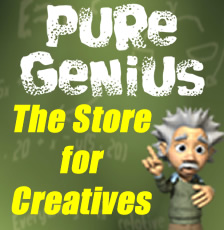‘20th Century Women’ – Annette Bening, Elle Fanning, Greta Gerwig Star
(First published on blogcritics.org)
When I first read about 20th Century Women, my initial reaction was that it’s not the kind of movie I’d like. But it had an interesting cast, so I watched the trailer and was hooked by the clever dialog. The writing is not all that’s good about 20th Century Women. The movie takes you on a cinematic joy ride while being at once heart-warming, sad, and funny. Already nominated for Golden Globe and Spirit Awards, I’d bet Oscar nominations are also in its future, particularly for Annette Bening’s amazing performance.
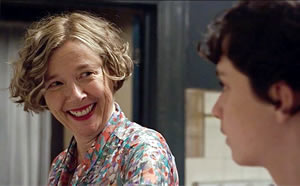
Annette Bening gives an Oscar-worthy performance in ‘20th Century Women’
At first glance, this seems like it’s going to be a coming-of-age film about 12-year-old Jamie, played by Lucas Jade Zumann (Sense8, Sinister 2). His mom, tells him all she wants is for him, “To be a good man.” What that means drives the story forward.
It’s 1979, and Jamie’s mom, child-of-the-depression single mom Dorothea, played by Annette Bening (American Beauty, Being Julia), is facing challenges raising him. She enlists the help of two women, baby-boomer artist Abbie, played by Greta Gerwig (No Strings Attached, Mistress America), and gen-Xer neighbor Julie, played by Elle Fanning (Maleficent, The Neon Demon). Jamie, however, is the only one in the story who doesn’t change as these three women are caught up in personal chaos and the tumultuous zeitgeist of the late 1970s.
Bening’s character sums things up when she talks to Abbie who has just discovered that because of a bout with cervical cancer, she will never be able to have children: “This is the really hard part. And then what happens is, there’s a hard part but then it gets better. Then it gets hard again. Maybe I shouldn’t have told you that last part.”
The film begins with Dorothea and Jamie emerging from a supermarket to find her car engulfed in flames. From there we are taken through school problems, birth-control pills and pregnancy tests, music ranging from Rudy Vallee to Talking Heads, female orgasm as a feminist issue, cancer, President Jimmy Carter’s Malaise Speech, menstruation, and a birthday party. The story is told in a non-sequential, graphically unconventional style that left me alternately confused and delighted.
I watched the film at the Los Angeles Film School, where the screening was followed by a question and answer session with writer/director Mike Mills (Thumbsucker, Beginners), conducted by Backstory Magazine publisher Jeff Goldsmith. Mills discussed the inspiration for the story and his work as a filmmaker.
The Inspiration
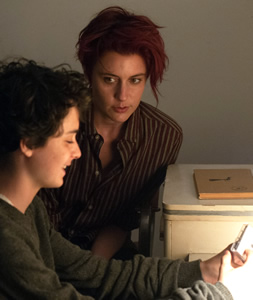
Greta Gerwig councils Lucas Jade Zumann in ‘20th Century Women’
Though not an autobiography, the film was inspired by Mills’ mother and the Jamie character is based on himself. Goldsmith asked Mills if the film was a fictionalized version of his adolescence. “I prefer the term ‘cinematized’,” Mills said. He admitted that, like the Jamie character, he was into skateboards and punk rock. “The Abbie character is based on my sister,” he said, “and Julie was based on two girls that I knew who were, shall we say, very hot. I was not on their shelf, but they would sneak into my room at night and tell me things. I heard my first woman-to-woman conversation laying between them on a bed. It was very educational.”
His bed, like the location of the film, was in Santa Barbara, a privileged beach community between Los Angeles and San Francisco. In the film, Dorothea lives in a run-down mansion she is renovating, within which she rents rooms to artist/photographer Abbie and ex-hippy handyman William, played by Billy Crudup (Jackie, Eat, Pray, Love). William is the only man in Jamie’s life, but they don’t connect. The construction scaffolding on the outside of the building allows Julie to sneak into Jamie’s room at night undetected.
It is in his room that Abbie tells Jamie and Julie, “Get out of this town before you end up working in a sunglasses shop.” In real life, Mills did, escape to San Francisco.
In San Francisco Mills created his career as an artist and music video producer.
The Creation
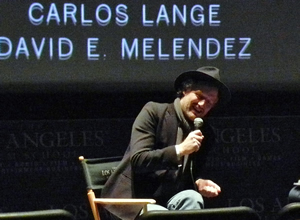
Writer/director Mike Mills discussed ‘20th Century Women’ at the Los Angeles Film School
Goldsmith asked Mills about how he developed the script and how he dealt with the many non-conventional aspects of his film such as sped up motion, colors out of registration, multiple narrations, and the lack of conventional structure.
Mills said that although he respected screenplay structure guru Robert McKee and had learned many things from his books, this story was different. “McKee doesn’t know how to deal with these things that are too alive and feral for his formulas.”
Although, usually I am a stickler for good story structure, when I realized about halfway through the film that this was not following any structure I could find, I also realized, in this case, I didn’t care. Another rule Mills breaks includes having multiple narrators. Jamie, begins the narration, but then other characters also break in to comment on the story.
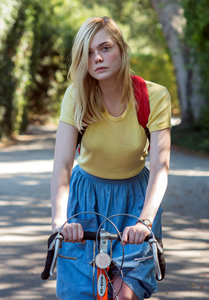
Elle Fanning plays a neighbor who knows too much about the world
Mills plays with time as well. It is somewhat shocking when Dorothea begins telling you about events twenty years in the future. The overall effect for me was as if I had experienced these events with these characters and was remembering things. Mills messed with my brain.
Ultimately, Mills said, he ends up with piles of note cards. He then puts them in a rough order in a shoe box and finally turns it into an outline. “I like Fellini’s idea,” he said. “A story is like a mistress you have to court. You just can’t go over and grab it. Like Fellini, I wanted this story to have forward thrust, displacement and surprise. It is about glimmers of connection. I wanted to honor those moments of grace.”As for the other unusual elements of the production, Mills said, “When I start, my practice is to be as free as I can. I don’t want to see Final Draft (screenwriting software) or an outline. I want things to be uncontrolled. I write things on note cards, have conversations, little trees grow, and then I figure out how to put them all together.”
A preview of 20th Century Women is linked below. It is, rated “R”, and opens in theaters on December 25. More information is available on its Facebook page and Twitter.

